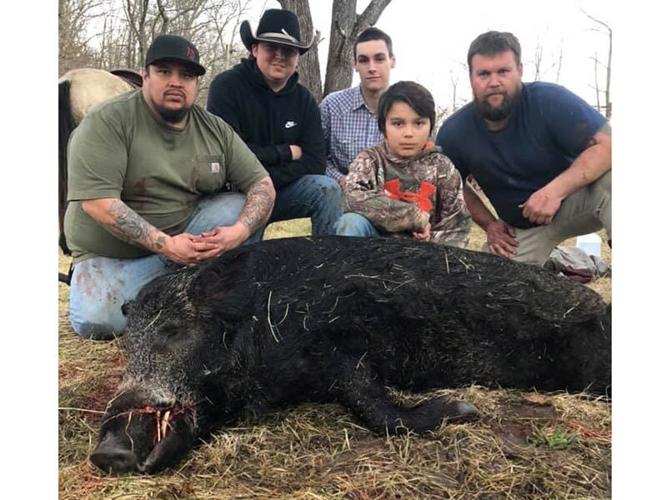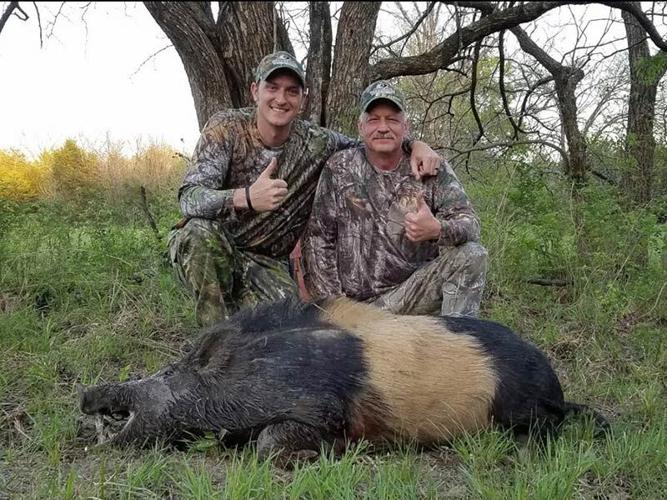TAHLEQUAH -- In Oklahoma, it's wild pig season every day of the year.
If a hunter wants to harvest feral swine, there are no limitations in terms of hunting seasons, daily takes or possession limits. The Oklahoma Department of Wildlife Conservation considers the animals a nuisance, and not a game species, though some hunters harvest the meat.
However, online accounts and the ODWC website acknowledge that hunters seeking other game harvest wild pigs as "targets of opportunity."
Greg Ward, a Cherokee Nation citizen in Cleveland, Oklahoma, said he shoots them if he sees them. "I have shot some, but mainly when I was deer hunting," he said. "I would shoot every pig I saw if I could. They are a menace."
Ward shot his first wild boar as a college student around 1990. He had never seen one in the area before 1989. He was home from school and hunting near Terlton, and his first encounter resulting in a harvested boar left him nervous.
"We were deer hunting, and we heard them take off running," he said. "We ran after them, and by the time we got close enough to see them, they were all around us. I shot one, and luckily they all ran off. I've shot others, including two big ones at the same time, but I was always deer hunting at the time."
There are others who specifically hunt wild boar; sometimes in Paleolithic fashion.
Tanner Garrett is a U.S. Army soldier and CN citizen who lives in Colorado. He hunts boars with a spear or knife, and with the assistance of dogs.
"There are two types of dogs: baying dogs and catch dogs," Garrett said. "The baying dogs often have some kind of hound in them because their job is to find the boar's scent and call out to the hunter when the dog has found it. The catch dogs usually have some pit bull in them for jaw strength, because once the hunter finds the boar, he releases the catch dog to grab hold of the boar so the hunter can get close and take it."
Garrett said boars have a "strap" of thick cartilage across their backs, which can reduce a firearm's effectiveness.
"Most also have a pair of razor-sharp tusks, whetted by its molars each time it chews," he said. "Those tusks are the reason many catch dogs wear either leather or Kevlar armor. Otherwise, you could expect to lose them during a hunt."
Garrett said he considers his attack like any other hunter. He may not be using a rifle, but he still wants the "kill shot."
"The spear takes a boar faster than anything I have seen," he said. "Mine is about seven feet long, a foot and a half of which is the spearhead. It cuts through them effortlessly. If you thrust forward and down behind the shoulder, the spear slices their heart in two and they drop almost immediately."
Garrett said a thrust that's "overzealous or missed" could have serious consequences for the dogs and hunters. He also regards the animals with much respect. Some studies suggest pigs possess intelligence comparable to 3-year-old humans. A reason for their success in the wild is their adaptability. Behavioral tests indicate pigs have a degree of problem solving skills, and they seem to accurately differentiate between humans who are threats and those who aren't.
A collation of several animal brainpower lists put pigs third behind humans and chimpanzees and ahead of dolphins, whales, elephants, parrots and dogs.
"Rule number one is to always keep the spear between you and the boar," Garrett said. "They can shake a dog loose in a flash and be on you in the blink of an eye. That is part of the reason I like it. You gain a firsthand, up close, and potentially consequential appreciation of them as animals and warriors."
Garrett said he only takes one wild boar per hunt because a single kill keeps his family supplied with pork for months, and his hunts are not frequent due to the risks faced by the dogs, his companions and himself.
"When it comes up, some people remark on how brutal the whole thing is -- and they are not wrong," he said. "That animal had more of a fighting chance than any ham sandwich you could buy at a grocery store, and I had to earn it far more than just handing over a few dollars for my trouble. Sure, there are easier, more efficient ways to hunt wild boar, but for me taking one should be a meaningful, consequential thing. The intimacy of a spear keeps me honest in that."
An abundance of pork wandering the Oklahoma forests might entice some hunters. Ward said youthful pigs are prized, but meat can be harvested from older boars.
"The younger ones are good, but you can get back straps out of even the bigger ones that are good to eat," Ward said. "I'm also sure that you can use meat from older boars to make sausage and bacon. I know it's pretty common. I've cooked some, smoked some, and it tastes different than domestic."
Garrett's method may seem too inefficient to control the feral swine population, but widespread firearm hunting and trapping efforts in Texas and elsewhere in the South have done little to slow the pigs' expansion north and west.
"People around here shoot tons and tons, and there are just getting to be a lot more," Ward said. "I have buddies who trap them. They trap with a remotely operated gate and a live camera feed. When they get 20 or 30 pigs in there, they close it. Some don't shoot pigs because they think it will ruin their deer hunt, and pigs reproduce so quickly. I honestly think controlling their population would require hunting, trapping and shooting at them from helicopters."




